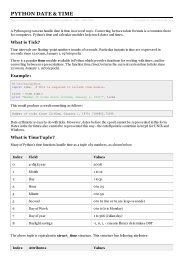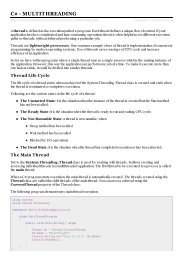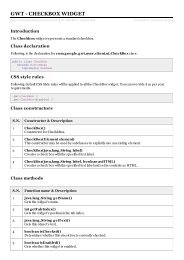download pascal tutorial (pdf - Tutorials Point
download pascal tutorial (pdf - Tutorials Point
download pascal tutorial (pdf - Tutorials Point
Create successful ePaper yourself
Turn your PDF publications into a flip-book with our unique Google optimized e-Paper software.
Incrementing a <strong>Point</strong>er<br />
We prefer using a pointer in our program instead of an array because the variable pointer<br />
can be incremented, unlike the array name, which cannot be incremented because it is a<br />
constant pointer. The following program increments the variable pointer to access each<br />
succeeding element of the array:<br />
program ex<strong>Point</strong>ers;<br />
const MAX = 3;<br />
var<br />
arr: array [1..MAX] of integer = (10, 100, 200);<br />
i: integer;<br />
iptr: ^integer;<br />
y: ^word;<br />
begin<br />
(* let us have array address in pointer *)<br />
iptr := @arr[1];<br />
for i := 1 to MAX do<br />
begin<br />
y:= addr(iptr);<br />
writeln('Address of arr[', i, '] = ' , y^ );<br />
writeln(' Value of arr[', i, '] = ' , iptr^ );<br />
(* move to the next location *)<br />
inc(iptr);<br />
end;<br />
end.<br />
When the above code is compiled and executed, it produces the following result:<br />
Address of arr[1] = 32880<br />
Value of arr[1] = 10<br />
Address of arr[2] = 32882<br />
Value of arr[2] = 100<br />
Address of arr[3] = 32884<br />
Value of arr[3] = 200<br />
Decrementing a <strong>Point</strong>er<br />
The same considerations apply to decrementing a pointer, which decreases its value by the<br />
number of bytes of its data type as shown below:<br />
TUTORIALS POINT<br />
Simply Easy Learning Page 94
















